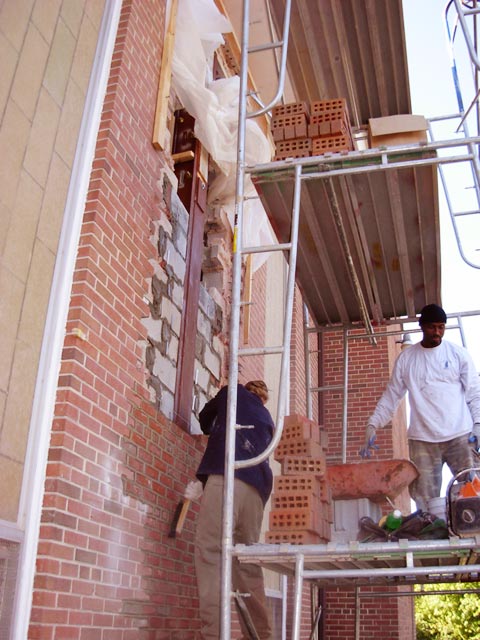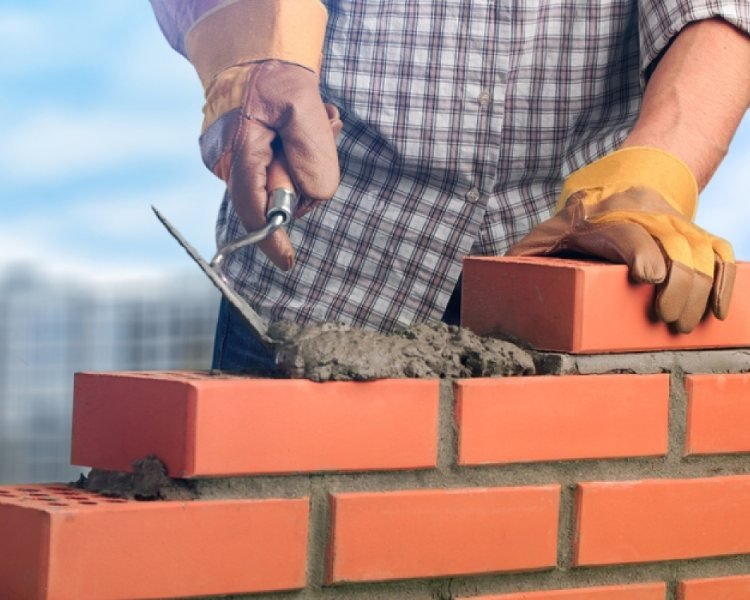Dependable Tuckpointing Services for Mending Block and Stone Surfaces
Wiki Article
Opening the Keys of Lasting Stonework Construction Practices for Eco-Friendly Buildings
In the realm of modern construction, the pursuit of lasting practices has ended up being extremely important. Amongst the myriad strategies to environmentally friendly structure, sustainable masonry building stands apart as a time-tested and resilient method that holds a riches of untapped possibility. From the option of products to ingenious construction strategies, the tricks to accomplishing sustainability within masonry building are multifaceted and interesting. By checking out the benefits, products, strategies, and future trends of lasting masonry, a much deeper understanding of exactly how these methods can shape the future of environment-friendly buildings arises.Benefits of Sustainable Stonework Construction
Embracing sustainable masonry construction techniques not just minimizes ecological impact but also provides lasting financial benefits to builders and areas. By making use of products like recycled blocks, obstructs, and stones, contractors can considerably lower the carbon impact of their jobs while promoting source efficiency. In addition, lasting masonry building strategies, such as appropriate insulation and thermal mass properties, can improve power effectiveness within structures, bring about decreased functional costs over time.Additionally, the durability and strength of masonry structures add to long-lasting financial benefits. Structures created utilizing sustainable stonework methods often call for less upkeep and fixing, equating to set you back financial savings for contractors and property proprietors. The longevity of stonework products likewise ensures that structures remain steady and safe and secure, decreasing the demand for regular improvements or replacements.
Eco-Friendly Stonework Materials
Making use of environment-friendly stonework materials is an essential step towards improving the sustainability of building and construction practices and minimizing ecological influence while making the most of long-term economic advantages. Sustainable stonework materials are sourced, produced, and made use of in a manner that reduces overall ecological impact. Materials such as recycled blocks, reclaimed stone, and lasting cinder block are ending up being significantly preferred selections for eco-conscious home builders. Recycled blocks, for example, not just divert waste from landfills but additionally require less energy to generate compared to new bricks. Redeemed stone supplies a distinct aesthetic charm while reducing the requirement for new quarrying. Sustainable concrete obstructs include recycled accumulations and might include improved insulation residential or commercial properties, adding to energy efficiency in buildings.Moreover, natural products like adobe, rammed earth, and straw bundles supply outstanding thermal mass residential or commercial properties, lowering the requirement for heating and cooling down energy. These materials are frequently in your area offered, promoting local economic climates and reducing transportation-related carbon exhausts. By picking environmentally friendly stonework products, construction projects can considerably reduce their environmental impact and add to the production of healthier, more lasting developed settings.
Energy-Efficient Masonry Methods
Power effectiveness plays a vital role in improving the sustainability of stonework construction practices. By applying energy-efficient masonry strategies, building contractors can significantly decrease the general energy usage of a structure, bring about reduced operational expenses and a smaller sized environmental footprint. One crucial energy-efficient stonework technique is the usage of thermal mass, which entails incorporating dense products like concrete or block into the structure's framework to absorb and save heat. This assists manage indoor temperatures, minimizing the demand for mechanical heating and cooling systems.
Technologies in Lasting Stonework
Current improvements in sustainable stonework practices have caused cutting-edge methods that are improving the building and construction industry. One such technology is the advancement of self-healing concrete, which makes use of bacteria embedded within the concrete to recover cracks autonomously. This innovation not just reduces upkeep prices however also enhances the durability of stonework frameworks, contributing to their sustainability.
One more noteworthy innovation is using recycled accumulations in masonry construction - masonry contractor. By including materials such as smashed ceramic waste or recycled glass into concrete mixes, contractors can reduce the environmental influence of construction projects while keeping architectural honesty. This practice not just draws away waste from land fills however also saves all-natural resources, making it a crucial advancement in sustainable masonry construction
Additionally, the combination of electronic design tools, such as Building Information Modeling (BIM), is reinventing the means masonry frameworks are intended and created. BIM enables more accurate calculations, minimized material my link waste, and boosted power efficiency, inevitably bring about even more sustainable building methods. These technologies collectively symbolize an encouraging future for lasting stonework building in the age of green structures.
Future Trends in Masonry Sustainability
With the cutting-edge strides made in lasting masonry methods, the future patterns in stonework sustainability are positioned to more reinvent the building and construction industry. Among the vital fads shaping the future of masonry sustainability is the increased assimilation of modern technology. Developments such as Building Information Modeling (BIM) and digital truth simulations are being made use of to enhance masonry construction procedures, causing lowered product waste and enhanced energy effectiveness in structures.Additionally, the development of unique additional resources sustainable products is set to play a significant duty in improving the eco-friendliness of stonework construction. masonry contractor. Innovations like self-healing concrete, recycled accumulations, and bio-based binders are obtaining grip for their capability to minimize ecological influence while preserving architectural stability

Conclusion
To conclude, sustainable stonework construction techniques offer various advantages for environmentally friendly buildings. By making use of environment-friendly materials and energy-efficient methods, stonework can add to an extra sustainable built environment. Advancements in lasting stonework are continuously being established to additionally improve the ecological performance of structures. Looking in the direction of the future, the fad of stonework sustainability is expected to expand, leading to more great site environmentally friendly and energy-efficient building techniques in the years ahead.Report this wiki page